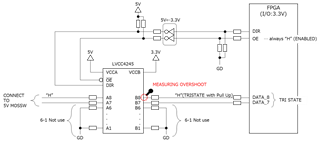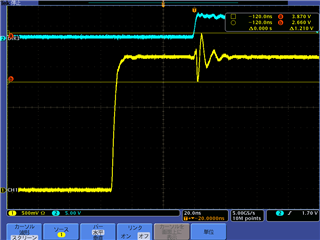Other Parts Discussed in Thread: SN74LXC8T245
Hello,
I would like to know about glitch caused by switching Direction.
I measured waveform at B8 pin the figure below, I have noticed glitches occuring.

OE:always "ENABLE", A8="H", B8="H"(Tristate with pullup)
The waveforms are shown below.

The glitch level exceeds the absolute maximum rating(VCCB 3.3+0.5 = 3.8V < 3.87V), I guess some action is needed.
I think the glitches caused by swtching DIR("L" to "H", DIR3 measured SN74LVCC4245 DIR pin).
I have 3 questions about it.
Q1. Is this behavior within T.I's expectations?
Q2. Could you tell me what I can do to prevent this glitch?
Q3. If there are any exceptions to the maximum ratings, please let us know what they are.
Best Regards,
Matsushita

